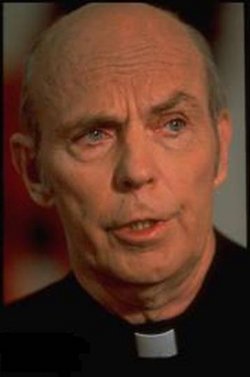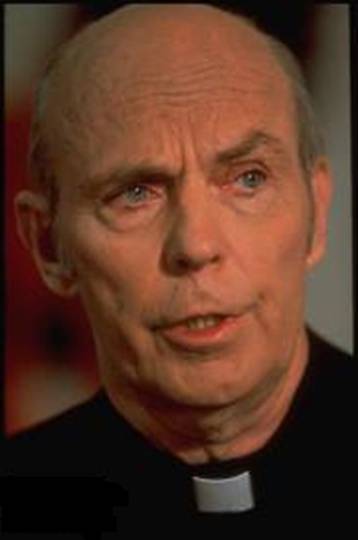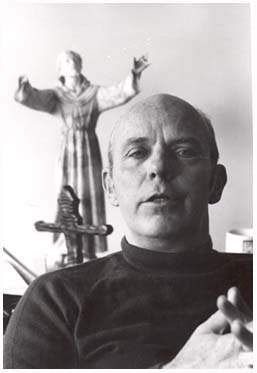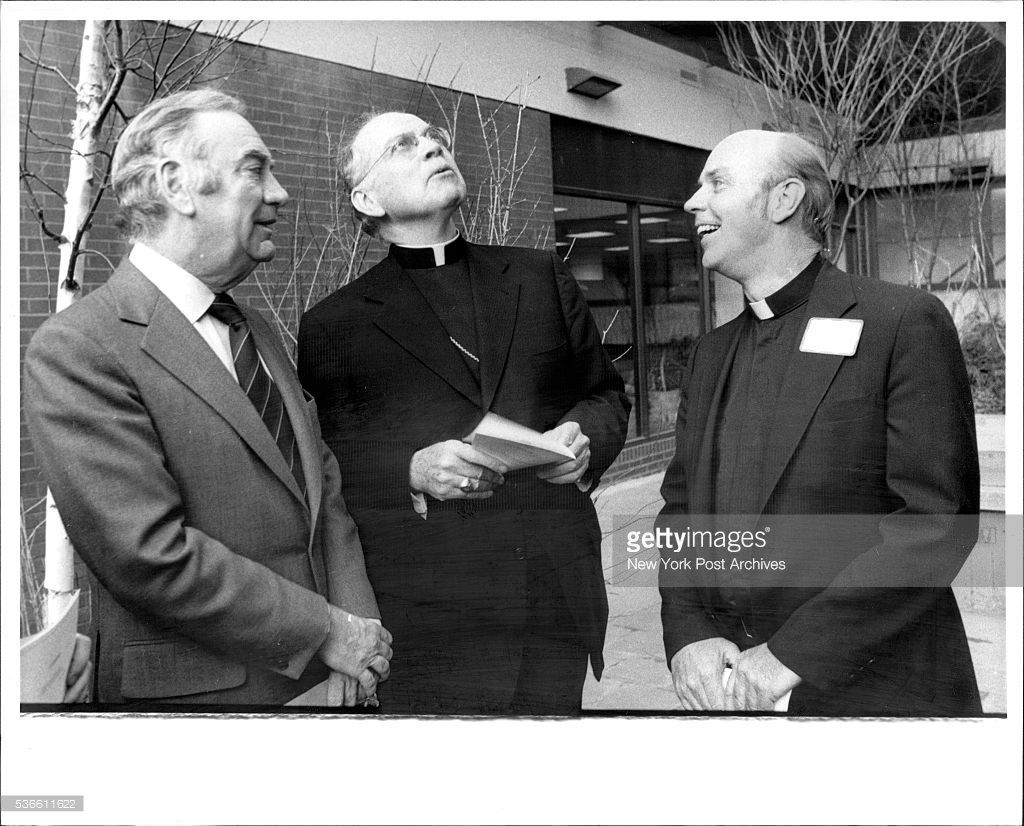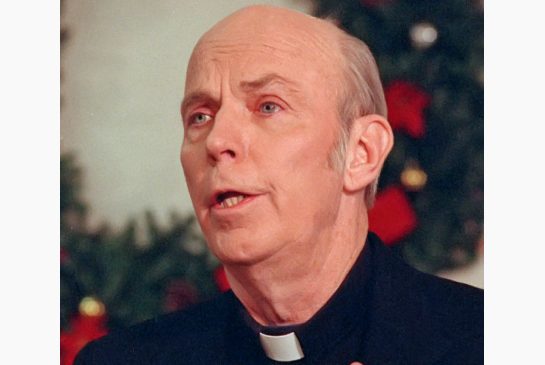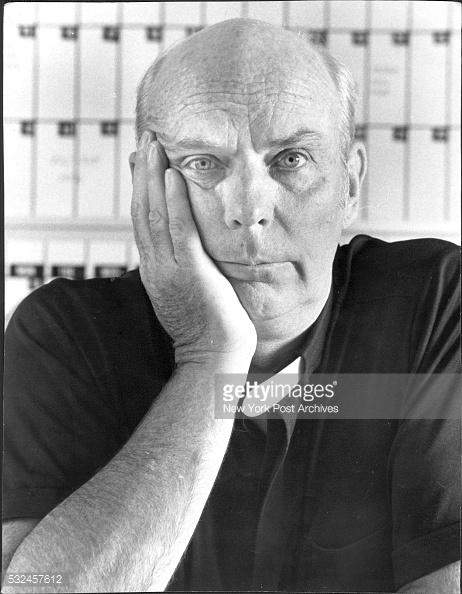Bruce Ritter, 72, died of Hodgkin's Disease on Thursday, October 7, 1999, in near seclusion in this Otsego County town, population 356.
A Roman Catholic priest and one-time Franciscan Conventual Friar who founded the charity Covenant House in 1972, for homeless teenagers, from which he was forced to resign in 1990, after accusations that he had engaged in financial improprieties and had engaged in sexual relations with several youth in the care of the charity, Father Ritter was born in Trenton, New Jersey, and grew up in nearby Hamilton Township. His father died in 1931, and his mother struggled financially during the 1930's, raising five children on a widow's pension and a series of odd jobs. Ritter graduated from Hamilton High School in 1945, worked briefly in a local industry, and joined the United States Navy near the end of the Second World War. Entering the Order of Friars Minor Conventuals in 1947, taking the name Bruce, he transferred for a time to explore monastic life as a Trappist, but returned and eventually was ordained as a Franciscan in 1956. Father Bruce completed his doctoral thesis on "The Primacy and the Council of Florence" at the Conventual Seminary in Rome in 1959, but never revised or published it in an academic journal. After a series of short-term teaching assignments at a variety of Franciscan institutions, Ritter arrived at Manhattan College in the Bronx to teach theology in 1963.
In 1968, Ritter decided to leave the college and to begin a new ministry on the Lower East Side of New York City. He recruited a fellow Franciscan Friar, Father James Fitzgibbon, to move to this troubled neighborhood and initiate what he described as a "ministry of availability" to the poor. The Archdiocese of New York assigned Ritter and Fitzgibbon to the local parish, St. Brigid's church, which had been designated as an experimental parish, in that it was structured around a team ministry. The Franciscans lived in a tenement building on East 7th Street, in what was a high-crime neighborhood, riddled by drug use. The friars were not immune to this situation, and their apartment was frequently broken into and robbed. One time, even Father Bruce's religious habit was taken by the thieves. Gradually they accumulated a following of young volunteers who moved to the East Village, Manhattan and surrounding apartments in an effort to live in community and effect social and political change. Fitzgibbon soon left the ministry, but several other individuals, including Adrian Gately, Patricia Kennedy, and Paul Frazier, proved instrumental in defining the early years.
By the early 1970's, Ritter decided to focus his efforts on sheltering homeless youths, as the issue of "runaways" was receiving considerable national media attention and the Greenwich Village area appeared to be a magnet that attracted many homeless youths. He formally incorporated his ministry as Covenant House in 1972, and received his first grant from the New York City Addiction Services Agency to support his work. Ritter soon began acquiring other properties and opened a series of boys' and girls' group homes, primarily in the Greenwich Village and East Village neighborhoods. In 1976, he announced plans to open a multi-service center for youths near the Port Authority Bus Terminal in the Times Square area. He began to obtain considerable publicity by claiming that he was rescuing youths who had arrived in New York City and had been lured into the child pornography and prostitution trade.
By the late 1980's, Covenant House had moved away from the small group home approach and opened large shelters with training programs in seven United States cities, as well as in Toronto and Latin America. Its budget approached US$90,000,000, and it spent three times what the federal government did on runaways. He called the teenagers in the Covenant House "my kids", "nice kids", and "gorgeous kids". Ritter wrote two books, "Covenant House: Lifeline to the Street" and "Sometimes God Has a Kid's Face", which detailed his experience in starting up Covenant House and provided his perspective on homeless teenagers.
In 1984, President Ronald Reagan praised Covenant House in his State of the Union address for their efforts in aiding homeless and runaway youth. In 1985, Ritter served on US Attorney General Edwin Meese's Commission on Pornography.
Father Ritter's caw was as one of the earliest and most highly publicized cases in the clergy sexual abuse scandal that subsequently emerged within the American Catholic Church. Despite mounting a vigorous public relations defense and denying any wrongdoing, Ritter was forced to resign from the organization in February 1990.
Ritter left the Franciscan Order, but retained his priestly faculties by being incardinated into a diocese in India. Father Ritter would visit St. Joseph's Abbey in Spencer, Mass., each month and often went on a retreat for Holy Week, as he had done when he lived in the city.
Bruce Ritter, 72, died of Hodgkin's Disease on Thursday, October 7, 1999, in near seclusion in this Otsego County town, population 356.
A Roman Catholic priest and one-time Franciscan Conventual Friar who founded the charity Covenant House in 1972, for homeless teenagers, from which he was forced to resign in 1990, after accusations that he had engaged in financial improprieties and had engaged in sexual relations with several youth in the care of the charity, Father Ritter was born in Trenton, New Jersey, and grew up in nearby Hamilton Township. His father died in 1931, and his mother struggled financially during the 1930's, raising five children on a widow's pension and a series of odd jobs. Ritter graduated from Hamilton High School in 1945, worked briefly in a local industry, and joined the United States Navy near the end of the Second World War. Entering the Order of Friars Minor Conventuals in 1947, taking the name Bruce, he transferred for a time to explore monastic life as a Trappist, but returned and eventually was ordained as a Franciscan in 1956. Father Bruce completed his doctoral thesis on "The Primacy and the Council of Florence" at the Conventual Seminary in Rome in 1959, but never revised or published it in an academic journal. After a series of short-term teaching assignments at a variety of Franciscan institutions, Ritter arrived at Manhattan College in the Bronx to teach theology in 1963.
In 1968, Ritter decided to leave the college and to begin a new ministry on the Lower East Side of New York City. He recruited a fellow Franciscan Friar, Father James Fitzgibbon, to move to this troubled neighborhood and initiate what he described as a "ministry of availability" to the poor. The Archdiocese of New York assigned Ritter and Fitzgibbon to the local parish, St. Brigid's church, which had been designated as an experimental parish, in that it was structured around a team ministry. The Franciscans lived in a tenement building on East 7th Street, in what was a high-crime neighborhood, riddled by drug use. The friars were not immune to this situation, and their apartment was frequently broken into and robbed. One time, even Father Bruce's religious habit was taken by the thieves. Gradually they accumulated a following of young volunteers who moved to the East Village, Manhattan and surrounding apartments in an effort to live in community and effect social and political change. Fitzgibbon soon left the ministry, but several other individuals, including Adrian Gately, Patricia Kennedy, and Paul Frazier, proved instrumental in defining the early years.
By the early 1970's, Ritter decided to focus his efforts on sheltering homeless youths, as the issue of "runaways" was receiving considerable national media attention and the Greenwich Village area appeared to be a magnet that attracted many homeless youths. He formally incorporated his ministry as Covenant House in 1972, and received his first grant from the New York City Addiction Services Agency to support his work. Ritter soon began acquiring other properties and opened a series of boys' and girls' group homes, primarily in the Greenwich Village and East Village neighborhoods. In 1976, he announced plans to open a multi-service center for youths near the Port Authority Bus Terminal in the Times Square area. He began to obtain considerable publicity by claiming that he was rescuing youths who had arrived in New York City and had been lured into the child pornography and prostitution trade.
By the late 1980's, Covenant House had moved away from the small group home approach and opened large shelters with training programs in seven United States cities, as well as in Toronto and Latin America. Its budget approached US$90,000,000, and it spent three times what the federal government did on runaways. He called the teenagers in the Covenant House "my kids", "nice kids", and "gorgeous kids". Ritter wrote two books, "Covenant House: Lifeline to the Street" and "Sometimes God Has a Kid's Face", which detailed his experience in starting up Covenant House and provided his perspective on homeless teenagers.
In 1984, President Ronald Reagan praised Covenant House in his State of the Union address for their efforts in aiding homeless and runaway youth. In 1985, Ritter served on US Attorney General Edwin Meese's Commission on Pornography.
Father Ritter's caw was as one of the earliest and most highly publicized cases in the clergy sexual abuse scandal that subsequently emerged within the American Catholic Church. Despite mounting a vigorous public relations defense and denying any wrongdoing, Ritter was forced to resign from the organization in February 1990.
Ritter left the Franciscan Order, but retained his priestly faculties by being incardinated into a diocese in India. Father Ritter would visit St. Joseph's Abbey in Spencer, Mass., each month and often went on a retreat for Holy Week, as he had done when he lived in the city.
